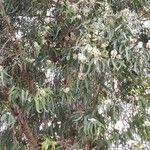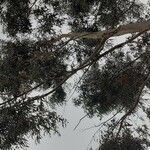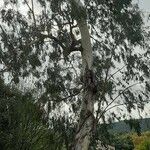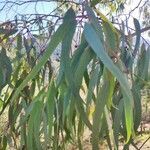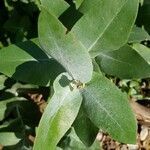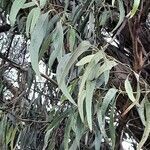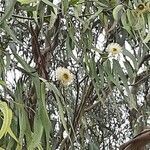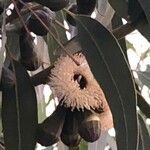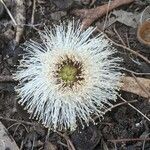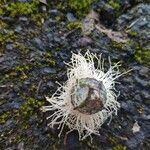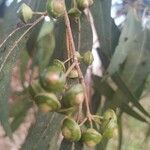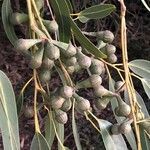Trees, large. Bark grayish blue, smooth, exfoliating. Branchlets slightly ridged. Young leaves opposite, sessile; leaf blade ovate, glaucescent, base cordate. Mature leaves with a slightly flattened 1.5-3 cm petiole; leaf blade lanceolate, 15-30 × 1-2 cm, falcate, leathery, both surfaces glandular, secondary veins at an angle of 35°-40° from midvein and inconspicuous, intramarginal veins ca. 1 mm from margin. Inflorescences axillary, simple, umbels 1-or 7-flowered; peduncles flattened or terete. Hypanthium obconic, ca. 1 × 1.3 cm, surface with 4 ridges and rugose protuberances, glaucescent; stipe 0-5 mm; calyptra slightly flattened, with a conic tubercle in middle, shorter than calyx tube, in 2 layers with outer layer glossy and caducous. Stamens 0.8-1.3 cm, in several whorls; filaments slender; anthers elliptic. Style 7-8 mm, stout. Capsule semiglobose, 0.6-2.4 cm in diam., 4-ridged; disk broad; valves 3-5, equaling hypanthium rim or exserted. Fl. Dec-May, fr. winter.
Tree 30–70 m tall with bark flaking off to reveal smooth white to cream, yellow or grey surface save at extreme base of trunk.. Juvenile leaves opposite, sessile and amplexicaul [ovate-oblong, cordate]; adult leaves lanceolate, 12–25 cm long, 1.7–3 cm wide, thick; petiole channelled or flattened, 2–3[–3.5] cm long.. Flowers solitary in leaf-axils (rarely in threes). Peduncle 0–6 mm long, compressed; pedicels absent or very short; buds turbinate to obconic, glaucous and warty; operculum flattened hemispherical, 0.7–1.5 cm long, 1.4–1.7 cm wide with prominent umbo.. Calyx-tube obconical, 1–1.2 cm long, 1.4–1.7 cm wide, ribbed.. Fruits obconic to hemispherical or subglobular, glaucous, 1–2.1 cm long, 1.4–2.4 cm wide with 3–5 flush or included valves; disc broad, level to ascending.. Fig. 6/15, p. 35.
Trees, usually to 45 m high, sometimes to 70 m. Bark usually smooth, white to cream, yellow or grey, but accumulated grey-brown, undecorticated bark at the trunk base. Juvenile leaves opposite, sessile, amplexicaul, ovate, grey-green to glaucous, discolorous. Adult leaves lanceolate to narrowly lanceolate, sometimes falcate, acuminate, green, concolorous. Umbels 1-, 3-or 7-flowered; peduncles flattened or terete; pedicels present or absent. Buds turbinate to obconical, warty glaucous; operculum flattened hemispherical, shortly umbonate; hypanthium obconical, ribbed or ± smooth. Fruits obconical to hemispherical or subglobular, glaucous or not; disc broad, level to ascending; valves 3–5, level or exserted. [For more recent description see subspecies profiles-Editor]
A spreading tree. It grows 15-50 m high. It spreads 10-25 m wide The bark is smooth and light yellow or grey. It sheds in strips. The inner bark is light green or brown. The young stems are square and the young leaves clasp the stems. They are oval and 15 cm long. The adult leaves are sickle shaped leaves 10-30 cm long. The flowers occur singly and are white to cream.
